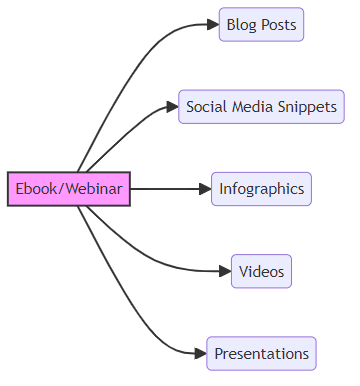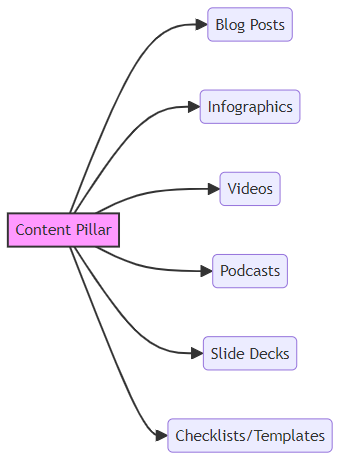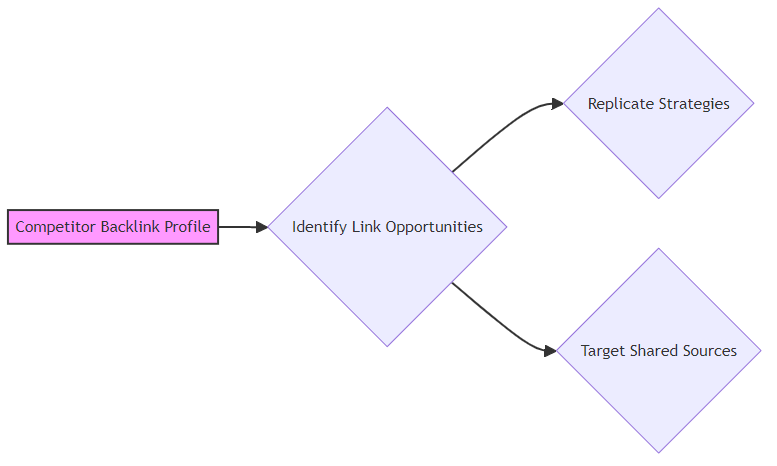Content Atomization: The Startup's Secret Weapon for Explosive Backlink Generation
Understanding Content Atomization and its Backlink Potential
Content atomization: the secret weapon for startups? It just might be. Ahrefs data shows that only 1 in 20 pages without backlinks gets any organic traffic, highlighting the critical importance of link building. (96.55% of Content Gets No Traffic From Google. Here's ...)
Content atomization involves breaking down a core piece of content into smaller, reusable components. These components can then be repurposed into various formats. Think of turning a webinar into blog posts, social media snippets, infographics, videos, and even presentations. The goal? To maximize content reach and impact without reinventing the wheel each time.

For example, a financial services company could atomize a detailed market analysis report into several blog posts focusing on specific sectors, along with infographics visualizing key data points. A retail business could transform a product launch webinar into short video demos for social media and a series of customer FAQs.
Startups often face resource constraints, making efficiency paramount. Content atomization allows for increased content output with minimal additional effort. It also helps reach a diverse audience by catering to different consumption preferences. Some prefer reading blog posts, while others prefer watching videos or browsing infographics.
Atomized content naturally attracts backlinks. By creating valuable, shareable assets, you increase the likelihood of other websites linking to your content. Different content formats can be targeted to specific audiences and publications, increasing relevance. Consistent, high-quality content establishes your startup as an industry expert, boosting brand authority.
Consider a B2B SaaS company that creates a comprehensive guide on marketing automation. They can then atomize this content into guest posts for marketing blogs, each linking back to the original guide. According to Markitors, backlinks are still important to help increase the authority of your website so that your content can outrank competitors. (How To Create Backlinks In SEO - Markitors)
Now that we understand the basics, let's dive deeper into specific atomization strategies.
Planning Your Content Atomization Strategy
Crafting a content atomization strategy is like charting a course for a long voyage—careful planning is essential for success. Without a clear plan, you risk creating content that misses the mark and fails to attract those valuable backlinks. Here’s how to set yourself up for success:
Start by pinpointing the core themes that resonate with your startup's expertise and your audience's interests. For example, a healthcare startup might focus on telehealth trends or innovations in patient care. Similarly, a fintech company could center its content around blockchain applications or personal finance tips.
- Choose topics aligned with your startup's expertise and target audience interests. This ensures your content is both authoritative and engaging.
- Conduct keyword research to identify high-potential topics. Tools like Google Keyword Planner (a free tool from Google for finding keywords) or Ahrefs (a comprehensive seo tool for keyword research and backlink analysis) can help you find keywords with significant search volume and low competition. (The 4 best free keyword research tools in 2025 - Zapier)
- Ensure core content pillars address key industry challenges and provide valuable solutions. This approach positions your startup as a thought leader.
Next, brainstorm the different content formats you can create from each core pillar. Think beyond blog posts. Consider infographics, videos, podcasts, slide decks, checklists, and templates.
- Brainstorm diverse content formats: blog posts, infographics, videos, podcasts, slide decks, checklists, templates.
- Consider the strengths of each format and its suitability for different audience segments. For example, visual learners might prefer infographics and videos, while those seeking in-depth information may prefer blog posts and ebooks.

- Create a content calendar to schedule the creation and distribution of atomized content. This ensures a consistent flow of content across different channels.
Finally, define SMART goals (Specific, Measurable, Achievable, Relevant, Time-bound) for your backlink acquisition efforts. How many backlinks do you aim to acquire in the next quarter? Which specific websites are you targeting?
- Define specific, measurable, achievable, relevant, and time-bound goals for backlink generation. This gives you a clear target to aim for and allows you to track your progress.
- Track backlink progress using seo tools. These tools help you monitor your backlink profile and identify new opportunities.
- Adjust the content atomization strategy based on performance data and insights. If certain content formats or topics are performing better than others, adjust your strategy accordingly.
With a well-defined plan in place, you're ready to start creating and distributing your atomized content. The next step involves diving into the nitty-gritty of content creation.
Creating Link-Worthy Atomized Content
Creating content that earns backlinks isn't about luck; it's about strategy. Think of each piece of atomized content as a potential magnet, drawing in links from relevant and authoritative websites.
The foundation of any successful content strategy often lies in well-written blog posts.
- Providing valuable insights, actionable tips, and data-driven evidence is essential. Don't just rehash existing information; offer a fresh perspective or unique data. For instance, a marketing startup could analyze recent social media trends and provide insights on how businesses can adapt their strategies.
- Optimizing blog posts for relevant keywords and search intent ensures they reach the right audience. Understand what your target audience is searching for and tailor your content accordingly. A financial services company, for example, might target keywords related to "retirement planning for millennials."
- Using clear headings, subheadings, and visuals to enhance readability keeps readers engaged. Break up long blocks of text with images, videos, or infographics. A healthcare startup could use visuals to explain complex medical concepts in an easy-to-understand way.
Infographics are a highly shareable format. They are great for visualizing complex data in an accessible way.

- Visualizing complex data and information in an easily digestible format makes it more appealing. Instead of presenting raw data in a table, transform it into a visually engaging chart or graph. A retail business could create an infographic showcasing customer demographics and purchasing habits.
- Creating visually appealing designs that align with your brand identity reinforces brand recognition. Use consistent colors, fonts, and imagery across all your infographics. A fintech company could develop a series of infographics using its brand colors to illustrate key financial concepts.
- Promoting infographics on relevant websites and social media platforms increases their visibility. Share your infographics on platforms like Pinterest, LinkedIn, and Twitter. A B2B SaaS company could submit its infographics to industry-specific websites and blogs.
Video content continues to dominate the digital landscape. Creating engaging videos is a great way to attract links and increase brand awareness.
- Creating informative and engaging video content that addresses audience pain points is key. Focus on solving problems or answering common questions. A healthcare startup could create videos explaining different treatment options for a specific condition.
- Optimizing video titles, descriptions, and tags for relevant keywords helps improve search visibility. Use relevant keywords in your video titles and descriptions to attract viewers. A retail business could optimize its product demo videos with keywords related to "best summer dresses."
- Promoting videos on YouTube and other video-sharing platforms expands reach. Share your videos on YouTube, Vimeo, and other relevant platforms. A financial services company could create a YouTube channel with videos on personal finance tips.
By focusing on creating high-quality, engaging content in various formats, startups can significantly increase their chances of earning valuable backlinks. Next, we'll explore effective outreach strategies to amplify your content and attract even more links.
Strategic Backlink Outreach for Atomized Content
Want to boost your startup's backlink profile without breaking the bank? Strategic outreach to promote your atomized content is key. Let's explore how to connect with the right partners and get those valuable links.
The first step is to identify websites, blogs, and publications in your industry that are likely to link to your content. Think of them as potential allies in your backlink strategy.
- Research relevant websites: Use search engines and industry directories to find sites that cover topics related to your content. A healthcare startup, for example, might target medical journals, health news sites, and wellness blogs.
- Identify websites with a history of linking: Look for sites that have linked to similar content in the past. Tools like Ahrefs or Semrush (both comprehensive seo platforms) can help you find these sites. This shows they're open to linking to relevant resources.
- Build a database: Compile a list of potential link partners, including their website URLs, contact information (email addresses, social media profiles), and notes on their content focus. This will be your go-to resource for outreach.
Generic, mass-emailed outreach rarely works. Personalization is critical to stand out and build relationships.
- Personalize each email: Address the recipient by name, reference their recent work, and demonstrate that you've genuinely engaged with their content. Show them you're not just sending a template.
- Highlight the value: Explain how your content would benefit their audience. What unique insights or resources do you offer? Why should they link to your content over others?
- Offer exclusive content: Consider offering exclusive content, such as a summary infographic or early access to a new report, to incentivize link placement. Give them a reason to feature your content prominently.
Guest posting can be a win-win: you get a backlink, and the host website gets valuable content. It does require careful planning and execution.
- Identify reputable websites: Find websites in your industry that accept guest posts and have a strong domain authority. Look for sites with active readership and a clear editorial process.
- Pitch unique ideas: Don't just recycle existing content. Propose fresh, valuable content ideas that align with the website's audience and your startup's expertise.
- Include relevant backlinks: Seamlessly integrate backlinks to your website within the guest post content. Ensure the links are relevant to the topic and provide additional value to the reader.
By strategically identifying link partners, crafting personalized outreach, and leveraging guest posting, startups can significantly boost their backlink profiles. Now, let's delve into the tools and techniques for automating these outreach efforts.
Advanced Link Building Tactics with Atomized Content
Looking to take your link building to the next level? Beyond the standard outreach and content creation, lies a realm of advanced tactics that can significantly boost your startup's backlink profile.
Broken link building is like treasure hunting for seo. It involves finding broken links on relevant websites and offering your content as a replacement. Here's how it works:
Identifying broken links: Use tools like Semrush or Ahrefs (comprehensive seo platforms) to scan websites in your niche for broken links (404 errors).
Creating replacement content: Develop content that directly replaces the information that was on the now-defunct page. For example, if a page about "best seo tools" is broken, create your own comprehensive list.
Reaching out to website owners: Contact the website owner, point out the broken link, and suggest your relevant content as a replacement. A simple, personalized email can go a long way.
Subject: Broken link on [Website Name]Hi [Name],
I noticed a broken link on your page about [Topic]. I recently created a resource on the same topic that might be a good replacement.
Best,
[Your Name]To find the website owner's email, you can often use tools like Hunter.io or simply look for a "Contact Us" page on their website. Including a brief summary of your replacement content or a link to a relevant section can also be beneficial.
It's a missed opportunity when someone mentions your brand online but doesn't link back to your website. Turning these mentions into backlinks can be a relatively easy win.
- Monitoring brand mentions: Use tools like Google Alerts (a free service that monitors the web for new content) or Mention (a real-time media monitoring tool) to track online mentions of your brand, product, or key personnel.
- Identifying unlinked mentions: Sift through the mentions and identify those that don't include a hyperlink to your website.
- Reaching out for a backlink: Contact the website owner or author and politely request that they add a link to your site. Explain how a link would provide additional value to their readers. According to SearchLogistics, social signals play a role as a ranking factor.
Analyzing your competitors' backlinks can reveal valuable link-building opportunities that you may have missed. It's a bit like spying, but for seo.
Analyzing competitor backlinks: Use tools like Ahrefs or Semrush (comprehensive seo platforms) to examine your top competitors' backlink profiles. What websites are linking to them?
Replicating their strategies: Identify the tactics they're using to acquire backlinks, such as guest posting, resource page submissions, or content partnerships.
Targeting shared link sources: Focus on websites that link to multiple of your competitors but not to you. These sites are likely receptive to content in your industry.

These advanced tactics can help your startup build a stronger, more authoritative backlink profile. Now, let's explore the tools and techniques for automating these outreach efforts.
Measuring and Optimizing Your Backlink Strategy
Is your backlink strategy a well-oiled machine or a sputtering engine? Tracking the right metrics and making data-driven adjustments is crucial for maximizing your ROI. Let's dive into how to measure and optimize your backlink strategy.
To gauge the effectiveness of your backlink efforts, monitor key seo metrics. This includes domain authority, organic traffic, keyword rankings, and the total number of backlinks.
- Domain authority provides an overview of your website's overall strength.
- Organic traffic indicates how well your content attracts visitors from search engines.
- Keyword rankings show where your pages rank for targeted search terms.
- Backlink count provides a general sense of your link-building progress.
Use tools like Google Analytics (a free web analytics service that tracks and reports website traffic) and Semrush (a comprehensive seo platform) to track these metrics over time. These tools help you identify trends, measure progress, and spot areas that need improvement.
Not all backlinks are created equal, so it is important to assess the authority, relevance, and trustworthiness of your backlinks.
- Authority refers to the linking site's domain authority.
- Relevance indicates how closely the linking site's content aligns with yours.
- Trustworthiness assesses the linking site's reputation and credibility.
Identify and disavow toxic or low-quality backlinks, as they can harm your seo. To do this, use tools like Ahrefs or Semrush to analyze your backlink profile, looking for links from spammy sites, irrelevant content, or those with unnatural anchor text. Once identified, you can use Google's Disavow Tool to tell search engines to ignore these links. Focus on acquiring high-quality backlinks from reputable websites to boost your site's authority.
seo is an ever-evolving landscape, so continuous testing with different content formats and outreach strategies is important.
- Adapt your approach based on performance data and industry trends.
- Stay up-to-date with the latest seo best practices and algorithm updates.
- Continuously analyze what is working and what is not.
By consistently measuring and optimizing your backlink strategy, you can ensure your startup achieves maximum impact. Now, let's explore essential tools and techniques for automating outreach efforts.
Case Studies and Real-World Examples
Content atomization can transform a startup's backlink strategy, but how does it play out in the real world? Let's look at some examples and pitfalls to avoid.
Content atomization helped Startup X generate many backlinks and significantly boost organic traffic and revenue. Their most successful content formats and outreach strategies included:
- Blog posts: Startup X created informative blog posts from their core content, which helped them earn backlinks.
- Infographics: Visualizing data with infographics made the content shareable and link-worthy.
- Guest posting: Publishing guest posts on industry blogs drove traffic back to their site.
B2B SaaS Company Y used content atomization to establish itself as a thought leader, generate leads, and drive sales. Consistent content creation and distribution was key to building their brand:
- Ebooks and whitepapers: They broke down ebooks into blog posts and social media snippets.
- Webinars: Repurposing webinars into multiple content formats increased their reach.
- Social Media: Company Y was consistent with their content on social media and according to SearchLogistics, social signals play a role as a ranking factor.
To avoid common pitfalls, be sure to:
- Over-optimizing content for keywords can neglect the audience value, leading to fewer backlinks.
- Avoid spammy or unethical link-building tactics, as they can harm your website's reputation.
- Always track and analyze backlink performance to refine your content strategy.
By learning from these examples and avoiding common mistakes, startups can effectively leverage content atomization to build a strong backlink profile and boost their online visibility.





